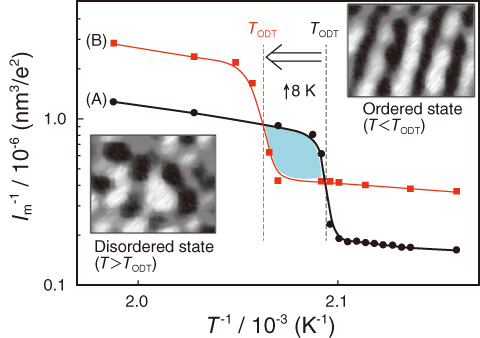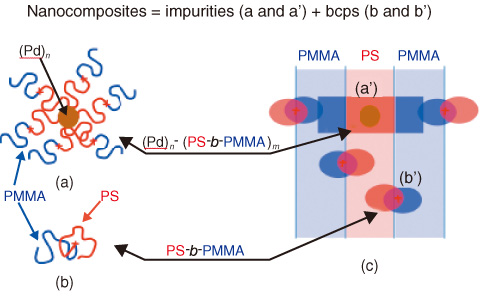
Fig.5-3 Effect of (Pd)ns on ODT

Fig.5-4 Interpretation of how (Pd)ns increase TODT
Nanocomposites made of block copolymer (bcp) templates and nano-additives have attracted much attention because bcps are well known to organize into diverse multiphase structures with nanoscale periodicity, and the incorporation of nano-additives is of great importance for manufacturing optoelectronic and mechanical devices. The nano-additives incorporated into bcps perturb the nature of the order-disorder transition (ODT) and the ODT temperature (TODT), which influences the thermal stability of the nanocomposites. Thus, the nanocomposite is thermally tunable, which might offer technological opportunities in the future. In this research, we describe how the incorporation of palladium nanoparticles, (Pd)ns, into a lamella-forming poly(styrene)-block-poly(methyl methacrylate) (PS-b-PMMA) alters its ODT.
(Pd)ns were incorporated into a PS-b-PMMA template by thermal reduction of Pd(acac)2 at 403 K. The ODT behavior of the neat bcp and the nanocomposites was investigated by small-angle X-ray scattering as a function of temperature (T). The plot of the inverse scattering intensity maximum (Im-1) vs. T -1 in Fig.5-3 indicates that the incorporation of ~1 wt% of (Pd)ns is sufficient to increase TODT by 8 K. This finding should be attributed to the fact that (Pd)ns increase the effective segregation power between the PS and PMMA block chains; a proposed explanation for this is selectively better incorporation of (Pd)ns into PS lamellae (~70 wt%) than into PMMA lamellae (~30 wt%). As illustrated in Fig.5-4, the attractive interactions bind some of the PS block chains to the surface of (Pd)ns and form impurities of (Pd)n-(PS-b-PMMA)m (a, a’) against neat bcps (b, b’) inside the lamellar template (c). The impurities serve as anchors that suppress Brownian motion of the bcp chains in the template both parallel and normal to the interfaces; hence, they thermally stabilize the lamellae and increase TODT.
Most importantly, the addition of (Pd)ns to the bcp template, as a strongly correlated system normal to the interface, is evidently able to change the ODT significantly, which offers new opportunities for the development of these nanocomposites.